Thermal gas mass flowmeters are instruments that use the principle of heat transfer to detect flow. In the 1960s, the United States first developed thermal mass flow meters for gas quality control required by the astronautics industry, then applied to manufacturing equipment in the semiconductor industry, which was exceptionally developed, and later expanded to other industrial applications. In recent years it has also been developed from measuring gases to liquids in industrial applications.
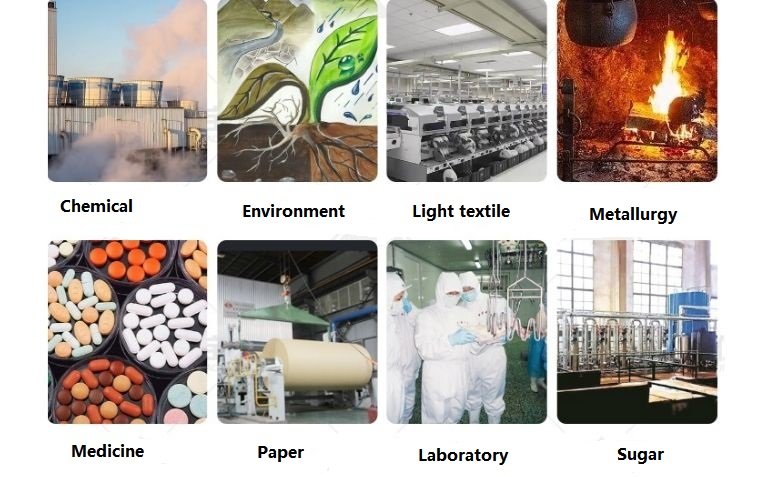
The working principle of thermal gas mass flowmeters
Thermal gas mass flowmeters use the thermal diffusion principle to measure the flow of gases. The sensor consists of two reference level RTDs (thermal resistance devices). One is a velocity sensor RH, and the other is a temperature sensor RMG which measures the change in gas temperature. When these two RTDs are placed in the gas being measured, one of the sensor’s RH is heated, and the other sensor RMG is used to sense the temperature of the gas being measured. As the gas flow rate increases, the gas stream picks up more heat, and the temperature of sensor RH decreases.
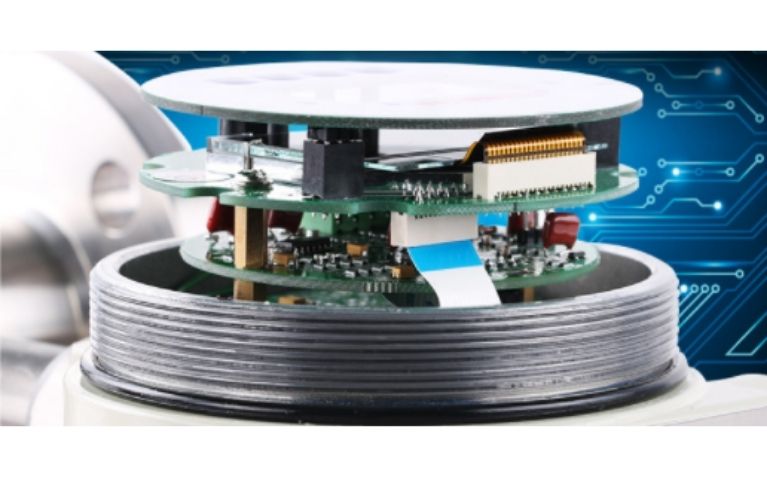
According to Golden’s law of thermal effects, the heating power P, the temperature difference ΔT (TRH-TRMG), and the mass flow rate Q have a defined mathematical relationship. P/∆T = K1 + K2 f (Q) K3 K1, K2, and K3 are constants related to the physical properties of the gas. The unique temperature difference measurement method of the thermal gas mass flow meter overcomes the disadvantages of using the constant temperature difference principle of the thermal gas mass flow meter to measure gas flow due to the large zero-point drift caused by the presence of water, oil, and impurities in the gas, resulting in the inability to measure.
Advantages and disadvantages of thermal gas mass flowmeters
1. Advantages of thermal gas mass flowmeters
1.1 High precision, no temperature, and pressure compensation. As can be seen from the measurement principle, the thermal gas mass flow meter directly measured fluid (gas) mass flow, no temperature and pressure compensation, the accuracy can reach ± 1% FS, can trade settlement.
1.2 Installation and maintenance costs are low. The thermal gas mass flowmeter structure is simple, generally does not need maintenance. If maintenance is required, it can be achieved online without stopping plugging maintenance.
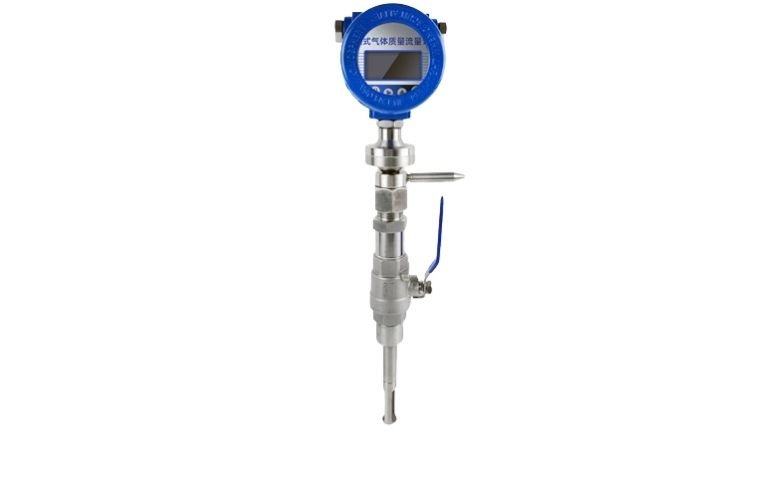
1.3 Especially suitable for large pipe diameter, low flow rate occasions. Insertion type thermal mass flowmeter applied to large diameter pipeline cost-effective.
1.4 The range ratio is large. Thermal gas mass flowmeter range ratio up to 100:1, thermal gas mass flow meter flow measurement lower limit is meager, almost from zero to start measuring, which is unmatched by other types of the gas flow meter.
1.5 Small pressure loss. Thermal gas flowmeter almost no pressure loss.
2. Disadvantages of thermal gas mass flowmeters
2.1 In the application, the gas entrained liquid will make the meter readings prominent. When the liquid on the probe is blown dry, the lessons return to normal.
2.2 If the gas contains dust and water vapor after the gas temperature drops, the dust and water will condense and mix, polluting the probe, affecting the transfer of heat, and making the measurement results low.
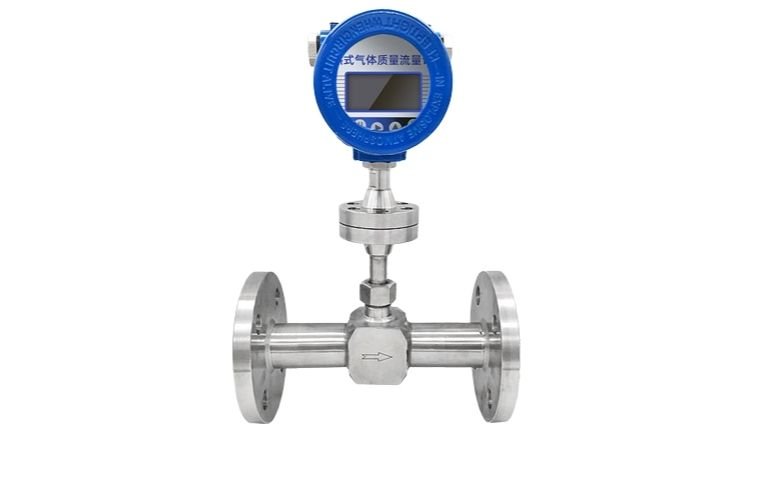
2.3 In some two-phase flow, multi-phase flow, the specific gravity of the gas mixture changes, the measured value will also have an impact. Therefore, the thermal gas mass flowmeter is not suitable for media containing a large amount of water. Media components are unstable, collecting impurities and dust on more occasions.
Installation of thermal gas mass flowmeters
- Check that the sensor and transmitter serial numbers are the same. (Split meter)
- Range and power of input power (DC or AC).
- Check whether the 4 to 20mA output circuit has a power supply (non-two-wire connection).
- Pay attention to the applicable temperature range of the sensor to avoid over-temperature working of the sensor. Also, pay attention to the table installed in the furnace closer to the pipe to prevent tempering when the furnace is stopped so that the sensor over-temperature damage.
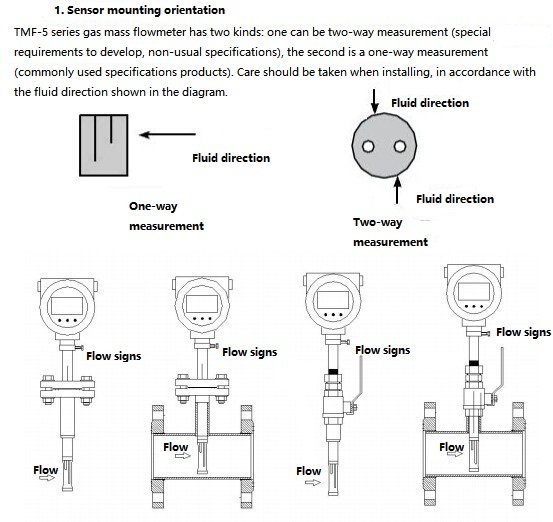
5. If a metal ferrule-type process connection is used, do not lock the ferrule tightly before commissioning the equipment. Otherwise, it will affect the adjustment of the sensor insertion depth after commissioning.
6. When installing the in-line instrument, ensure that the overall structure of the instrument is intact and that no part of the connection is disassembled.
7. When installing the sensor, pay attention to making the small plane marked with the flow arrow parallel to the process medium flow direction and making the flow arrow point to the process medium flow direction.
8. For sensors installed on the side of horizontal pipes, ensure that the heating end is above the reference end.
9. For applications where the medium may contain water (e.g., gas), it is recommended that the sensor be mounted at an angle of 45° upwards.
10. Pay attention to the sealing of the electrical interface to prevent water and moisture from entering the package through the electrical interface and causing corrosion damage to the wiring section.
Common faults and treatment methods
- Flow fluctuations; processing methods: check whether the flowmeter parameters are set correctly, check whether the sensor probe is contaminated, if the sensor can be plugged in with pressure, can pull out the sensor probe cleaning.
- Flowmeter display full range; processing methods: first should understand whether the process flow changes, media flow increases beyond the measurement range of the instrument; check whether the sensor wiring is wrong, there may be one or several sensing or excitation wire lose or short-circuit, be heated RTD work reference RTD disconnection or short-circuit; whether the process changes caused by the media with liquid, if necessary, you can remove the sensor probe, confirm the probe has not been contaminated and with liquid.
- Flowmeter measurement value is low; treatment: check the flowmeter sensor RTD resistance and heater resistance is normal; whether the impurities within the medium cured on the sensor probe, remove the sensor probe cleaning.
Daily maintenance precautions
- Periodically check the cable wiring to confirm that the connections are secure.
- Confirm that the seals on the electronic parts of the local and remote packages are intact and that no moisture has entered the package.
- Periodically check that the electrical wiring is not corroded and that the insulation of the cables is not affected by aging.
- The sensor must not be subject to excessive contamination; any adsorbed material can cause inaccurate measurements. Therefore carry out regular cleaning when necessary.
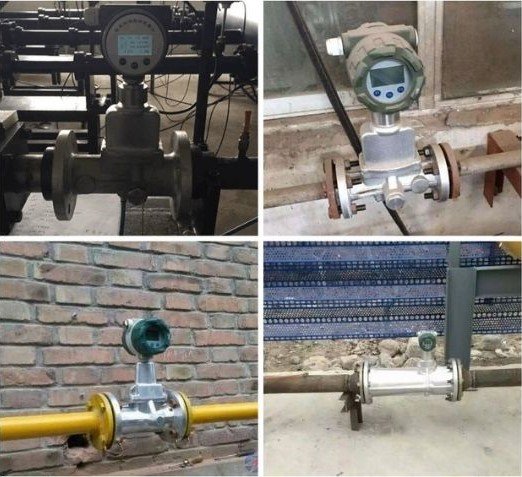
Conclusion
Thermal flowmeters are increasingly used for their simple structure, reliability, and low cost. In the foreseeable future, the proportion of thermal flowmeters used in flow metering will increase further. In the development process of small flow control technology, the use and development of thermal mass flowmeters are an essential part of it. Master suitable thermal mass flowmeter troubleshooting methods and gradually figure out the flowmeter routine maintenance and precautions to improve the level of small flow control technology to ensure the stable operation of petrochemical plants.

